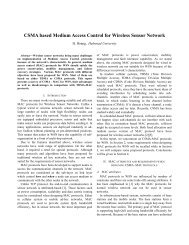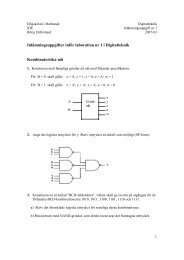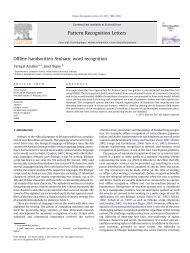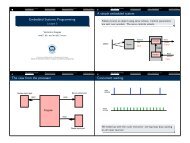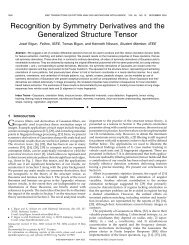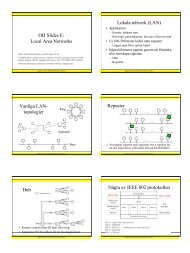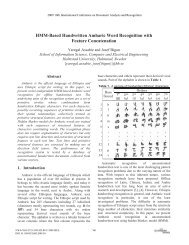viewing
viewing
viewing
Create successful ePaper yourself
Turn your PDF publications into a flip-book with our unique Google optimized e-Paper software.
Recap Probe-Echo algorithms Syncronous communication<br />
Concurrent Programming<br />
Asyncronous and synchronous message passing<br />
1 Recap<br />
2 Probe-Echo algorithms<br />
broadcast<br />
calculating the topology<br />
3 Syncronous communication<br />
November 29<br />
www.hh.se/staff/vero/concurrent
Recap Probe-Echo algorithms Syncronous communication<br />
Distributed Programming<br />
Processes execute without sharing memory, they collaborate by<br />
communicating with each other. Processes exchange messages<br />
with each other.<br />
Asynchronous Message Passing<br />
Communication channels can be used by means of<br />
send, non blocking.<br />
receive, blocking.
Recap Probe-Echo algorithms Syncronous communication<br />
Distributed Programming<br />
Processes execute without sharing memory, they collaborate by<br />
communicating with each other. Processes exchange messages<br />
with each other.<br />
Asynchronous Message Passing<br />
Communication channels can be used by means of<br />
send, non blocking.<br />
receive, blocking.
Recap Probe-Echo algorithms Syncronous communication<br />
Distributed Programming<br />
Processes execute without sharing memory, they collaborate by<br />
communicating with each other. Processes exchange messages<br />
with each other.<br />
Asynchronous Message Passing<br />
Communication channels can be used by means of<br />
send, non blocking.<br />
receive, blocking.
Recap Probe-Echo algorithms Syncronous communication<br />
Distributed Programming<br />
Processes execute without sharing memory, they collaborate by<br />
communicating with each other. Processes exchange messages<br />
with each other.<br />
Asynchronous Message Passing<br />
Communication channels can be used by means of<br />
send, non blocking.<br />
receive, blocking.
Recap Probe-Echo algorithms Syncronous communication<br />
Distributed programming<br />
Example<br />
In MPD,<br />
1 We distribute a program by placing resources in different<br />
virtual machines.<br />
2 Each resource might execute one or more processes (which<br />
share the local variables of the resource!)<br />
3 A resource that wants to communicate with some other<br />
resource must export some channel for that purpose.
Recap Probe-Echo algorithms Syncronous communication<br />
Distributed programming<br />
Example<br />
In MPD,<br />
1 We distribute a program by placing resources in different<br />
virtual machines.<br />
2 Each resource might execute one or more processes (which<br />
share the local variables of the resource!)<br />
3 A resource that wants to communicate with some other<br />
resource must export some channel for that purpose.
Recap Probe-Echo algorithms Syncronous communication<br />
Distributed programming<br />
Example<br />
In MPD,<br />
1 We distribute a program by placing resources in different<br />
virtual machines.<br />
2 Each resource might execute one or more processes (which<br />
share the local variables of the resource!)<br />
3 A resource that wants to communicate with some other<br />
resource must export some channel for that purpose.
Recap Probe-Echo algorithms Syncronous communication<br />
Distributed programming<br />
Example<br />
In MPD,<br />
1 We distribute a program by placing resources in different<br />
virtual machines.<br />
2 Each resource might execute one or more processes (which<br />
share the local variables of the resource!)<br />
3 A resource that wants to communicate with some other<br />
resource must export some channel for that purpose.
Recap Probe-Echo algorithms Syncronous communication<br />
MPD sensor network<br />
resource Sensor<br />
op deploy([*]cap Sensor nbgs)<br />
op chan(int id, double value)<br />
body Sensor(int identity, int interval, int netSize)<br />
[netSize] cap Sensor neighbours<br />
int nrOfNeighbours<br />
procedure measure(){...}<br />
procedure communicate(){...}<br />
procedure work(){co measure() // communicate() oc}<br />
proc deploy(nbgs){<br />
nrOfNeighbours = ub(nbgs)-lb(nbgs) + 1<br />
for[i = 1 to nrOfNeighbours]{neighbours[i]=nbgs[i]}<br />
work()<br />
}<br />
end
Recap Probe-Echo algorithms Syncronous communication<br />
MPD sensor network<br />
resource Sensor<br />
op deploy([*]cap Sensor nbgs)<br />
op chan(int id, double value)<br />
body Sensor(int identity, int interval, int netSize)<br />
[netSize] cap Sensor neighbours<br />
int nrOfNeighbours<br />
procedure measure(){...}<br />
procedure communicate(){...}<br />
procedure work(){co measure() // communicate() oc}<br />
proc deploy(nbgs){<br />
nrOfNeighbours = ub(nbgs)-lb(nbgs) + 1<br />
for[i = 1 to nrOfNeighbours]{neighbours[i]=nbgs[i]}<br />
work()<br />
}<br />
end
Recap Probe-Echo algorithms Syncronous communication<br />
MPD sensor network<br />
resource Sensor<br />
op deploy([*]cap Sensor nbgs)<br />
op chan(int id, double value)<br />
body Sensor(int identity, int interval, int netSize)<br />
[netSize] cap Sensor neighbours<br />
int nrOfNeighbours<br />
procedure measure(){...}<br />
procedure communicate(){...}<br />
procedure work(){co measure() // communicate() oc}<br />
proc deploy(nbgs){<br />
nrOfNeighbours = ub(nbgs)-lb(nbgs) + 1<br />
for[i = 1 to nrOfNeighbours]{neighbours[i]=nbgs[i]}<br />
work()<br />
}<br />
end
Recap Probe-Echo algorithms Syncronous communication<br />
MPD sensor network<br />
resource Sensor<br />
op deploy([*]cap Sensor nbgs)<br />
op chan(int id, double value)<br />
body Sensor(int identity, int interval, int netSize)<br />
[netSize] cap Sensor neighbours<br />
int nrOfNeighbours<br />
procedure measure(){...}<br />
procedure communicate(){...}<br />
procedure work(){co measure() // communicate() oc}<br />
proc deploy(nbgs){<br />
nrOfNeighbours = ub(nbgs)-lb(nbgs) + 1<br />
for[i = 1 to nrOfNeighbours]{neighbours[i]=nbgs[i]}<br />
work()<br />
}<br />
end
Recap Probe-Echo algorithms Syncronous communication<br />
MPD sensor network<br />
resource Sensor<br />
op deploy([*]cap Sensor nbgs)<br />
op chan(int id, double value)<br />
body Sensor(int identity, int interval, int netSize)<br />
[netSize] cap Sensor neighbours<br />
int nrOfNeighbours<br />
procedure measure(){...}<br />
procedure communicate(){...}<br />
procedure work(){co measure() // communicate() oc}<br />
proc deploy(nbgs){<br />
nrOfNeighbours = ub(nbgs)-lb(nbgs) + 1<br />
for[i = 1 to nrOfNeighbours]{neighbours[i]=nbgs[i]}<br />
work()<br />
}<br />
end
Recap Probe-Echo algorithms Syncronous communication<br />
MPD sensor network<br />
resource Sensor<br />
op deploy([*]cap Sensor nbgs)<br />
op chan(int id, double value)<br />
body Sensor(int identity, int interval, int netSize)<br />
[netSize] cap Sensor neighbours<br />
int nrOfNeighbours<br />
procedure measure(){...}<br />
procedure communicate(){...}<br />
procedure work(){co measure() // communicate() oc}<br />
proc deploy(nbgs){<br />
nrOfNeighbours = ub(nbgs)-lb(nbgs) + 1<br />
for[i = 1 to nrOfNeighbours]{neighbours[i]=nbgs[i]}<br />
work()<br />
}<br />
end
Recap Probe-Echo algorithms Syncronous communication<br />
MPD sensor network<br />
Example<br />
1 A program will create some sensors by letting each sensor run<br />
in its own virtual machine:<br />
cap Sensor s = create Sensor(id, interval, size)<br />
on machine<br />
2 and deploy the network by providing each sensor with its<br />
neighbours<br />
s.deploy(ns)<br />
(where ns is an array of sensors.)<br />
3 We then have a distributed program, where the sensors do<br />
some local work while they can also collaborate with each<br />
other to do some work together.
Recap Probe-Echo algorithms Syncronous communication<br />
MPD sensor network<br />
Example<br />
1 A program will create some sensors by letting each sensor run<br />
in its own virtual machine:<br />
cap Sensor s = create Sensor(id, interval, size)<br />
on machine<br />
2 and deploy the network by providing each sensor with its<br />
neighbours<br />
s.deploy(ns)<br />
(where ns is an array of sensors.)<br />
3 We then have a distributed program, where the sensors do<br />
some local work while they can also collaborate with each<br />
other to do some work together.
Recap Probe-Echo algorithms Syncronous communication<br />
MPD sensor network<br />
Example<br />
1 A program will create some sensors by letting each sensor run<br />
in its own virtual machine:<br />
cap Sensor s = create Sensor(id, interval, size)<br />
on machine<br />
2 and deploy the network by providing each sensor with its<br />
neighbours<br />
s.deploy(ns)<br />
(where ns is an array of sensors.)<br />
3 We then have a distributed program, where the sensors do<br />
some local work while they can also collaborate with each<br />
other to do some work together.
Recap Probe-Echo algorithms Syncronous communication<br />
MPD sensor network<br />
Example<br />
1 A program will create some sensors by letting each sensor run<br />
in its own virtual machine:<br />
cap Sensor s = create Sensor(id, interval, size)<br />
on machine<br />
2 and deploy the network by providing each sensor with its<br />
neighbours<br />
s.deploy(ns)<br />
(where ns is an array of sensors.)<br />
3 We then have a distributed program, where the sensors do<br />
some local work while they can also collaborate with each<br />
other to do some work together.
Recap Probe-Echo algorithms Syncronous communication<br />
Plan<br />
Today<br />
Process interaction in distributed programs:<br />
Probe-Echo algorithms using asynchronous message passing<br />
(MPD)<br />
Synchronous communication, reactive objects (MPD)<br />
Next lectures<br />
More constructions for communication: Remote Procedure<br />
Call (remote method invocation in Java).<br />
One new paradigm of interaction: client-server.
Recap Probe-Echo algorithms Syncronous communication<br />
Plan<br />
Today<br />
Process interaction in distributed programs:<br />
Probe-Echo algorithms using asynchronous message passing<br />
(MPD)<br />
Synchronous communication, reactive objects (MPD)<br />
Next lectures<br />
More constructions for communication: Remote Procedure<br />
Call (remote method invocation in Java).<br />
One new paradigm of interaction: client-server.
Recap Probe-Echo algorithms Syncronous communication<br />
Probe-Echo algorithms<br />
We assume processes are executing in distributed nodes (mpd<br />
resources).<br />
That some nodes can communicate with some other nodes can be<br />
modelled using graphs.<br />
Nodes are resources that can<br />
communicate with their<br />
neighbours in the graph.<br />
Nodes send probes to their<br />
neighbours and receive echos<br />
from them.
Recap Probe-Echo algorithms Syncronous communication<br />
Probe-Echo algorithms<br />
We assume processes are executing in distributed nodes (mpd<br />
resources).<br />
That some nodes can communicate with some other nodes can be<br />
modelled using graphs.<br />
Nodes are resources that can<br />
communicate with their<br />
neighbours in the graph.<br />
Nodes send probes to their<br />
neighbours and receive echos<br />
from them.
Recap Probe-Echo algorithms Syncronous communication<br />
Probe-Echo algorithms<br />
We assume processes are executing in distributed nodes (mpd<br />
resources).<br />
That some nodes can communicate with some other nodes can be<br />
modelled using graphs.<br />
Nodes are resources that can<br />
communicate with their<br />
neighbours in the graph.<br />
Nodes send probes to their<br />
neighbours and receive echos<br />
from them.
Recap Probe-Echo algorithms Syncronous communication<br />
Probe-Echo algorithms<br />
We assume processes are executing in distributed nodes (mpd<br />
resources).<br />
That some nodes can communicate with some other nodes can be<br />
modelled using graphs.<br />
Nodes are resources that can<br />
communicate with their<br />
neighbours in the graph.<br />
Nodes send probes to their<br />
neighbours and receive echos<br />
from them.
Recap Probe-Echo algorithms Syncronous communication<br />
Probe-Echo algorithms<br />
We assume processes are executing in distributed nodes (mpd<br />
resources).<br />
That some nodes can communicate with some other nodes can be<br />
modelled using graphs.<br />
Nodes are resources that can<br />
communicate with their<br />
neighbours in the graph.<br />
Nodes send probes to their<br />
neighbours and receive echos<br />
from them.
Recap Probe-Echo algorithms Syncronous communication<br />
Broadcast in a network<br />
Probes can be used for a process to broadcast a message to all<br />
other nodes in a network.<br />
1 Each resource will have a channel to do<br />
broadcast<br />
2 Each resource will have a process engaged in<br />
broadcast<br />
3 This process will<br />
1 wait to receive the message<br />
2 send it to all its neighbours<br />
4 Some other process in one resource starts<br />
the broadcast.
Recap Probe-Echo algorithms Syncronous communication<br />
Broadcast in a network<br />
Probes can be used for a process to broadcast a message to all<br />
other nodes in a network.<br />
1 Each resource will have a channel to do<br />
broadcast<br />
2 Each resource will have a process engaged in<br />
broadcast<br />
3 This process will<br />
1 wait to receive the message<br />
2 send it to all its neighbours<br />
4 Some other process in one resource starts<br />
the broadcast.
Recap Probe-Echo algorithms Syncronous communication<br />
Broadcast in a network<br />
Probes can be used for a process to broadcast a message to all<br />
other nodes in a network.<br />
1 Each resource will have a channel to do<br />
broadcast<br />
2 Each resource will have a process engaged in<br />
broadcast<br />
3 This process will<br />
1 wait to receive the message<br />
2 send it to all its neighbours<br />
4 Some other process in one resource starts<br />
the broadcast.
Recap Probe-Echo algorithms Syncronous communication<br />
Broadcast in a network<br />
Probes can be used for a process to broadcast a message to all<br />
other nodes in a network.<br />
1 Each resource will have a channel to do<br />
broadcast<br />
2 Each resource will have a process engaged in<br />
broadcast<br />
3 This process will<br />
1 wait to receive the message<br />
2 send it to all its neighbours<br />
4 Some other process in one resource starts<br />
the broadcast.
Recap Probe-Echo algorithms Syncronous communication<br />
Broadcast in a network<br />
Probes can be used for a process to broadcast a message to all<br />
other nodes in a network.<br />
1 Each resource will have a channel to do<br />
broadcast<br />
2 Each resource will have a process engaged in<br />
broadcast<br />
3 This process will<br />
1 wait to receive the message<br />
2 send it to all its neighbours<br />
4 Some other process in one resource starts<br />
the broadcast.
Recap Probe-Echo algorithms Syncronous communication<br />
Broadcast in a network<br />
Probes can be used for a process to broadcast a message to all<br />
other nodes in a network.<br />
1 Each resource will have a channel to do<br />
broadcast<br />
2 Each resource will have a process engaged in<br />
broadcast<br />
3 This process will<br />
1 wait to receive the message<br />
2 send it to all its neighbours<br />
4 Some other process in one resource starts<br />
the broadcast.
Recap Probe-Echo algorithms Syncronous communication<br />
Broadcast in a network<br />
Probes can be used for a process to broadcast a message to all<br />
other nodes in a network.<br />
1 Each resource will have a channel to do<br />
broadcast<br />
2 Each resource will have a process engaged in<br />
broadcast<br />
3 This process will<br />
1 wait to receive the message<br />
2 send it to all its neighbours<br />
4 Some other process in one resource starts<br />
the broadcast.
Recap Probe-Echo algorithms Syncronous communication<br />
Doesn’t work!<br />
What will happen in the next broadcast?<br />
Because a node might be a<br />
neighbour to more than one node,<br />
there might be many messages<br />
sent to its broadcast channel!<br />
They will be read in the next<br />
receive, instead for the new<br />
message being broadcast!<br />
Empty the channel by receiving from all other neighbours (and<br />
throwing the messages away!)
Recap Probe-Echo algorithms Syncronous communication<br />
Doesn’t work!<br />
What will happen in the next broadcast?<br />
Because a node might be a<br />
neighbour to more than one node,<br />
there might be many messages<br />
sent to its broadcast channel!<br />
They will be read in the next<br />
receive, instead for the new<br />
message being broadcast!<br />
Empty the channel by receiving from all other neighbours (and<br />
throwing the messages away!)
Recap Probe-Echo algorithms Syncronous communication<br />
Doesn’t work!<br />
What will happen in the next broadcast?<br />
Because a node might be a<br />
neighbour to more than one node,<br />
there might be many messages<br />
sent to its broadcast channel!<br />
They will be read in the next<br />
receive, instead for the new<br />
message being broadcast!<br />
Empty the channel by receiving from all other neighbours (and<br />
throwing the messages away!)
Recap Probe-Echo algorithms Syncronous communication<br />
Doesn’t work!<br />
What will happen in the next broadcast?<br />
Because a node might be a<br />
neighbour to more than one node,<br />
there might be many messages<br />
sent to its broadcast channel!<br />
They will be read in the next<br />
receive, instead for the new<br />
message being broadcast!<br />
Empty the channel by receiving from all other neighbours (and<br />
throwing the messages away!)
Recap Probe-Echo algorithms Syncronous communication<br />
Works!<br />
The algorithm<br />
In each resource the process engaged in broadcast will<br />
1 Receive the message in a dedicated channel<br />
2 Send the message to all its neighbours<br />
3 Receive in the dedicated channel as many times as number of<br />
neighbours -1.<br />
How does everything start?<br />
In some resource, an initiator process will send the original message<br />
to the broadcast process in that resource!<br />
What happens with the boadcast process in the resource of the<br />
initiator? What can be done about it?
Recap Probe-Echo algorithms Syncronous communication<br />
Works!<br />
The algorithm<br />
In each resource the process engaged in broadcast will<br />
1 Receive the message in a dedicated channel<br />
2 Send the message to all its neighbours<br />
3 Receive in the dedicated channel as many times as number of<br />
neighbours -1.<br />
How does everything start?<br />
In some resource, an initiator process will send the original message<br />
to the broadcast process in that resource!<br />
What happens with the boadcast process in the resource of the<br />
initiator? What can be done about it?
Recap Probe-Echo algorithms Syncronous communication<br />
Works!<br />
The algorithm<br />
In each resource the process engaged in broadcast will<br />
1 Receive the message in a dedicated channel<br />
2 Send the message to all its neighbours<br />
3 Receive in the dedicated channel as many times as number of<br />
neighbours -1.<br />
How does everything start?<br />
In some resource, an initiator process will send the original message<br />
to the broadcast process in that resource!<br />
What happens with the boadcast process in the resource of the<br />
initiator? What can be done about it?
Recap Probe-Echo algorithms Syncronous communication<br />
Works!<br />
The algorithm<br />
In each resource the process engaged in broadcast will<br />
1 Receive the message in a dedicated channel<br />
2 Send the message to all its neighbours<br />
3 Receive in the dedicated channel as many times as number of<br />
neighbours -1.<br />
How does everything start?<br />
In some resource, an initiator process will send the original message<br />
to the broadcast process in that resource!<br />
What happens with the boadcast process in the resource of the<br />
initiator? What can be done about it?
Recap Probe-Echo algorithms Syncronous communication<br />
Works!<br />
The algorithm<br />
In each resource the process engaged in broadcast will<br />
1 Receive the message in a dedicated channel<br />
2 Send the message to all its neighbours<br />
3 Receive in the dedicated channel as many times as number of<br />
neighbours -1.<br />
How does everything start?<br />
In some resource, an initiator process will send the original message<br />
to the broadcast process in that resource!<br />
What happens with the boadcast process in the resource of the<br />
initiator? What can be done about it?
Recap Probe-Echo algorithms Syncronous communication<br />
Works!<br />
The algorithm<br />
In each resource the process engaged in broadcast will<br />
1 Receive the message in a dedicated channel<br />
2 Send the message to all its neighbours<br />
3 Receive in the dedicated channel as many times as number of<br />
neighbours -1.<br />
How does everything start?<br />
In some resource, an initiator process will send the original message<br />
to the broadcast process in that resource!<br />
What happens with the boadcast process in the resource of the<br />
initiator? What can be done about it?
Recap Probe-Echo algorithms Syncronous communication<br />
A better broadcast<br />
In the previous algorithm there were many messages that were sent<br />
and then just discarded! Could a process guide the message?<br />
. . . it can construct a spanning<br />
tree . . .<br />
If the initiator node S knows all of<br />
the graph . . .<br />
. . . where each node can find its<br />
relevant neighbours for the<br />
broadcast!<br />
The spanning tree has to be sent<br />
as part of the message!
Recap Probe-Echo algorithms Syncronous communication<br />
A better broadcast<br />
In the previous algorithm there were many messages that were sent<br />
and then just discarded! Could a process guide the message?<br />
If the initiator node S knows all of<br />
the graph . . .<br />
. . . it can construct a spanning<br />
tree . . .<br />
. . . where each node can find its<br />
relevant neighbours for the<br />
broadcast!<br />
The spanning tree has to be sent<br />
as part of the message!
Recap Probe-Echo algorithms Syncronous communication<br />
A better broadcast<br />
In the previous algorithm there were many messages that were sent<br />
and then just discarded! Could a process guide the message?<br />
If the initiator node S knows all of<br />
the graph . . .<br />
. . . it can construct a spanning<br />
tree . . .<br />
. . . where each node can find its<br />
relevant neighbours for the<br />
broadcast!<br />
The spanning tree has to be sent<br />
as part of the message!
Recap Probe-Echo algorithms Syncronous communication<br />
A better broadcast<br />
In the previous algorithm there were many messages that were sent<br />
and then just discarded! Could a process guide the message?<br />
If the initiator node S knows all of<br />
the graph . . .<br />
. . . it can construct a spanning<br />
tree . . .<br />
. . . where each node can find its<br />
relevant neighbours for the<br />
broadcast!<br />
The spanning tree has to be sent<br />
as part of the message!
Recap Probe-Echo algorithms Syncronous communication<br />
A better broadcast<br />
In the previous algorithm there were many messages that were sent<br />
and then just discarded! Could a process guide the message?<br />
If the initiator node S knows all of<br />
the graph . . .<br />
. . . it can construct a spanning<br />
tree . . .<br />
. . . where each node can find its<br />
relevant neighbours for the<br />
broadcast!<br />
The spanning tree has to be sent<br />
as part of the message!
Recap Probe-Echo algorithms Syncronous communication<br />
Gathering the topology<br />
Two steps<br />
1 Send a probe to all neighbours.<br />
2 Send back an echo with the partial topology to the process<br />
that sent the first probe.<br />
What is a graph?<br />
In this context we will model graphs using an adjacency matrix<br />
The spanning tree is also a graph!<br />
1 2 3 4 5 6 7<br />
1 f t f f f f t<br />
2 t f t f f t f<br />
3 f t f t t t f<br />
4 f f t f t f f<br />
5 f f t t f f t<br />
6 f t t f f f t<br />
7 t f f f t t f
Recap Probe-Echo algorithms Syncronous communication<br />
Gathering the topology<br />
Two steps<br />
1 Send a probe to all neighbours.<br />
2 Send back an echo with the partial topology to the process<br />
that sent the first probe.<br />
What is a graph?<br />
In this context we will model graphs using an adjacency matrix<br />
The spanning tree is also a graph!<br />
1 2 3 4 5 6 7<br />
1 f t f f f f t<br />
2 t f t f f t f<br />
3 f t f t t t f<br />
4 f f t f t f f<br />
5 f f t t f f t<br />
6 f t t f f f t<br />
7 t f f f t t f
Recap Probe-Echo algorithms Syncronous communication<br />
Gathering the topology<br />
Two steps<br />
1 Send a probe to all neighbours.<br />
2 Send back an echo with the partial topology to the process<br />
that sent the first probe.<br />
What is a graph?<br />
In this context we will model graphs using an adjacency matrix<br />
The spanning tree is also a graph!<br />
1 2 3 4 5 6 7<br />
1 f t f f f f t<br />
2 t f t f f t f<br />
3 f t f t t t f<br />
4 f f t f t f f<br />
5 f f t t f f t<br />
6 f t t f f f t<br />
7 t f f f t t f
Recap Probe-Echo algorithms Syncronous communication<br />
Gathering the topology<br />
Two steps<br />
1 Send a probe to all neighbours.<br />
2 Send back an echo with the partial topology to the process<br />
that sent the first probe.<br />
What is a graph?<br />
In this context we will model graphs using an adjacency matrix<br />
The spanning tree is also a graph!<br />
1 2 3 4 5 6 7<br />
1 f t f f f f t<br />
2 t f t f f t f<br />
3 f t f t t t f<br />
4 f f t f t f f<br />
5 f f t t f f t<br />
6 f t t f f f t<br />
7 t f f f t t f
Recap Probe-Echo algorithms Syncronous communication<br />
Gathering the topology<br />
Two steps<br />
1 Send a probe to all neighbours.<br />
2 Send back an echo with the partial topology to the process<br />
that sent the first probe.<br />
What is a graph?<br />
In this context we will model graphs using an adjacency matrix<br />
The spanning tree is also a graph!<br />
1 2 3 4 5 6 7<br />
1 f t f f f f t<br />
2 t f t f f t f<br />
3 f t f t t t f<br />
4 f f t f t f f<br />
5 f f t t f f t<br />
6 f t t f f f t<br />
7 t f f f t t f
Recap Probe-Echo algorithms Syncronous communication<br />
Gathering the topology<br />
Two steps<br />
1 Send a probe to all neighbours.<br />
2 Send back an echo with the partial topology to the process<br />
that sent the first probe.<br />
What is a graph?<br />
In this context we will model graphs using an adjacency matrix<br />
The spanning tree is also a graph!<br />
1 2 3 4 5 6 7<br />
1 f t f f f f t<br />
2 t f t f f t f<br />
3 f t f t t t f<br />
4 f f t f t f f<br />
5 f f t t f f t<br />
6 f t t f f f t<br />
7 t f f f t t f
Recap Probe-Echo algorithms Syncronous communication<br />
Gathering the topology<br />
Two steps<br />
1 Send a probe to all neighbours.<br />
2 Send back an echo with the partial topology to the process<br />
that sent the first probe.<br />
What is a graph?<br />
In this context we will model graphs using an adjacency matrix<br />
The spanning tree is also a graph!<br />
1 2 3 4 5 6 7<br />
1 f t f f f f t<br />
2 t f t f f t f<br />
3 f t f t t t f<br />
4 f f t f t f f<br />
5 f f t t f f t<br />
6 f t t f f f t<br />
7 t f f f t t f
Recap Probe-Echo algorithms Syncronous communication<br />
Calculating the topology<br />
The algorithm<br />
All resources involved in calculating the topology will use the<br />
following types:<br />
type graph = bool [n,n]<br />
type kind = enum (PROBE, ECHO)<br />
The resources export a channel<br />
op probe_echo(kind k, int sender, graph topology)<br />
The resource collecting the topology uses one extra channel<br />
op finalecho(graph topology)
Recap Probe-Echo algorithms Syncronous communication<br />
Calculating the topology<br />
The algorithm<br />
The resource s that will collect the topology starts everyting doing<br />
graph topology<br />
send probe_echo(PROBE,s,allFalse)<br />
receive finalecho(topology)<br />
All resources in the network will have a process involved in<br />
collecting the topology. For this it will use<br />
graph newtop, localtop # all false!<br />
Recall that each resource knows what resources are its neighbours<br />
bool links[n]
Recap Probe-Echo algorithms Syncronous communication<br />
Calculating the topology<br />
The algorithm<br />
1 Initialize localtop with links .<br />
2 Receive the probe from one neighbour (the first one!)<br />
3 Send the probe to all other neighbours!<br />
4 Receive redundant probes and echoes:<br />
If it is an echo, build the local topology by adding the received<br />
topology (Just a logical or between the matrices!)<br />
If it is a probe, send the empty topology as echo back to the<br />
sender.<br />
5 Send an echo back to the first sender (or to the finalecho if<br />
the process is executing in the resource s)
Recap Probe-Echo algorithms Syncronous communication<br />
Calculating the topology<br />
The algorithm<br />
1 Initialize localtop with links .<br />
2 Receive the probe from one neighbour (the first one!)<br />
3 Send the probe to all other neighbours!<br />
4 Receive redundant probes and echoes:<br />
If it is an echo, build the local topology by adding the received<br />
topology (Just a logical or between the matrices!)<br />
If it is a probe, send the empty topology as echo back to the<br />
sender.<br />
5 Send an echo back to the first sender (or to the finalecho if<br />
the process is executing in the resource s)
Recap Probe-Echo algorithms Syncronous communication<br />
Calculating the topology<br />
The algorithm<br />
1 Initialize localtop with links .<br />
2 Receive the probe from one neighbour (the first one!)<br />
3 Send the probe to all other neighbours!<br />
4 Receive redundant probes and echoes:<br />
If it is an echo, build the local topology by adding the received<br />
topology (Just a logical or between the matrices!)<br />
If it is a probe, send the empty topology as echo back to the<br />
sender.<br />
5 Send an echo back to the first sender (or to the finalecho if<br />
the process is executing in the resource s)
Recap Probe-Echo algorithms Syncronous communication<br />
Calculating the topology<br />
The algorithm<br />
1 Initialize localtop with links .<br />
2 Receive the probe from one neighbour (the first one!)<br />
3 Send the probe to all other neighbours!<br />
4 Receive redundant probes and echoes:<br />
If it is an echo, build the local topology by adding the received<br />
topology (Just a logical or between the matrices!)<br />
If it is a probe, send the empty topology as echo back to the<br />
sender.<br />
5 Send an echo back to the first sender (or to the finalecho if<br />
the process is executing in the resource s)
Recap Probe-Echo algorithms Syncronous communication<br />
Calculating the topology<br />
The algorithm<br />
1 Initialize localtop with links .<br />
2 Receive the probe from one neighbour (the first one!)<br />
3 Send the probe to all other neighbours!<br />
4 Receive redundant probes and echoes:<br />
If it is an echo, build the local topology by adding the received<br />
topology (Just a logical or between the matrices!)<br />
If it is a probe, send the empty topology as echo back to the<br />
sender.<br />
5 Send an echo back to the first sender (or to the finalecho if<br />
the process is executing in the resource s)
Recap Probe-Echo algorithms Syncronous communication<br />
Calculating the topology<br />
The algorithm<br />
1 Initialize localtop with links .<br />
2 Receive the probe from one neighbour (the first one!)<br />
3 Send the probe to all other neighbours!<br />
4 Receive redundant probes and echoes:<br />
If it is an echo, build the local topology by adding the received<br />
topology (Just a logical or between the matrices!)<br />
If it is a probe, send the empty topology as echo back to the<br />
sender.<br />
5 Send an echo back to the first sender (or to the finalecho if<br />
the process is executing in the resource s)
Recap Probe-Echo algorithms Syncronous communication<br />
Calculating the topology<br />
The algorithm<br />
1 Initialize localtop with links .<br />
2 Receive the probe from one neighbour (the first one!)<br />
3 Send the probe to all other neighbours!<br />
4 Receive redundant probes and echoes:<br />
If it is an echo, build the local topology by adding the received<br />
topology (Just a logical or between the matrices!)<br />
If it is a probe, send the empty topology as echo back to the<br />
sender.<br />
5 Send an echo back to the first sender (or to the finalecho if<br />
the process is executing in the resource s)
Recap Probe-Echo algorithms Syncronous communication<br />
Calculating the topology<br />
The algorithm<br />
1 Initialize localtop with links .<br />
2 Receive the probe from one neighbour (the first one!)<br />
3 Send the probe to all other neighbours!<br />
4 Receive redundant probes and echoes:<br />
If it is an echo, build the local topology by adding the received<br />
topology (Just a logical or between the matrices!)<br />
If it is a probe, send the empty topology as echo back to the<br />
sender.<br />
5 Send an echo back to the first sender (or to the finalecho if<br />
the process is executing in the resource s)
Recap Probe-Echo algorithms Syncronous communication<br />
Broadcasting revisited<br />
So, now we know that one resource (a node in the graph) can<br />
calculate the topology of the network by collaborating with other<br />
resources using a probe/echo pattern of communication.<br />
It is easy for that node to calculate a spanning tree<br />
Spanning tree<br />
A sub-graph with only one path from the root to any other node<br />
using some of the edges in the original graph.
Recap Probe-Echo algorithms Syncronous communication<br />
Broadcasting revisited<br />
So, now we know that one resource (a node in the graph) can<br />
calculate the topology of the network by collaborating with other<br />
resources using a probe/echo pattern of communication.<br />
It is easy for that node to calculate a spanning tree<br />
Spanning tree<br />
A sub-graph with only one path from the root to any other node<br />
using some of the edges in the original graph.
Recap Probe-Echo algorithms Syncronous communication<br />
Broadcasting revisited<br />
So, now we know that one resource (a node in the graph) can<br />
calculate the topology of the network by collaborating with other<br />
resources using a probe/echo pattern of communication.<br />
It is easy for that node to calculate a spanning tree<br />
Spanning tree<br />
A sub-graph with only one path from the root to any other node<br />
using some of the edges in the original graph.
Recap Probe-Echo algorithms Syncronous communication<br />
Broadcasting revisited<br />
So, now we know that one resource (a node in the graph) can<br />
calculate the topology of the network by collaborating with other<br />
resources using a probe/echo pattern of communication.<br />
It is easy for that node to calculate a spanning tree<br />
Spanning tree<br />
A sub-graph with only one path from the root to any other node<br />
using some of the edges in the original graph.
Recap Probe-Echo algorithms Syncronous communication<br />
Broadcasting revisited<br />
So, now we know that one resource (a node in the graph) can<br />
calculate the topology of the network by collaborating with other<br />
resources using a probe/echo pattern of communication.<br />
It is easy for that node to calculate a spanning tree<br />
Spanning tree<br />
A sub-graph with only one path from the root to any other node<br />
using some of the edges in the original graph.
Recap Probe-Echo algorithms Syncronous communication<br />
calculating a spanning tree
Recap Probe-Echo algorithms Syncronous communication<br />
Broadcasting revisited<br />
The algorithm<br />
Let the channel that all resources export deal with both messages<br />
and a spanning tree:<br />
op probe(double value, graph sptree)<br />
Then the process in each resource involved in the broadcast will<br />
just<br />
1 Receive the message and the spanning tree (from only one<br />
process!)<br />
2 Send the message and the spanning tree only to the<br />
neighbours in the spanning tree!
Recap Probe-Echo algorithms Syncronous communication<br />
Broadcasting revisited<br />
The algorithm<br />
Let the channel that all resources export deal with both messages<br />
and a spanning tree:<br />
op probe(double value, graph sptree)<br />
Then the process in each resource involved in the broadcast will<br />
just<br />
1 Receive the message and the spanning tree (from only one<br />
process!)<br />
2 Send the message and the spanning tree only to the<br />
neighbours in the spanning tree!
Recap Probe-Echo algorithms Syncronous communication<br />
Broadcasting revisited<br />
The algorithm<br />
Let the channel that all resources export deal with both messages<br />
and a spanning tree:<br />
op probe(double value, graph sptree)<br />
Then the process in each resource involved in the broadcast will<br />
just<br />
1 Receive the message and the spanning tree (from only one<br />
process!)<br />
2 Send the message and the spanning tree only to the<br />
neighbours in the spanning tree!
Recap Probe-Echo algorithms Syncronous communication<br />
Broadcasting revisited<br />
The algorithm<br />
Let the channel that all resources export deal with both messages<br />
and a spanning tree:<br />
op probe(double value, graph sptree)<br />
Then the process in each resource involved in the broadcast will<br />
just<br />
1 Receive the message and the spanning tree (from only one<br />
process!)<br />
2 Send the message and the spanning tree only to the<br />
neighbours in the spanning tree!
Recap Probe-Echo algorithms Syncronous communication<br />
Rendezvouz<br />
It is very difficult to synchronize processes using asyncronous<br />
message passing! We would like to attack problems like waiting on<br />
conditions in the setting of distributed programming.<br />
Think of the primitive of sending a message to another process<br />
leaving the sender process suspended until the message is received<br />
and processed! At that point the processes can handshake or<br />
rendezvous.<br />
The receiving operation will have a queue of waiting processes,<br />
instead of a queue of messages!<br />
Implementations of these primitives in programming languages can<br />
include<br />
Returning a value to the calling process!<br />
Add conditions to the receive primitive for blocking senders!
Recap Probe-Echo algorithms Syncronous communication<br />
Rendezvouz<br />
It is very difficult to synchronize processes using asyncronous<br />
message passing! We would like to attack problems like waiting on<br />
conditions in the setting of distributed programming.<br />
Think of the primitive of sending a message to another process<br />
leaving the sender process suspended until the message is received<br />
and processed! At that point the processes can handshake or<br />
rendezvous.<br />
The receiving operation will have a queue of waiting processes,<br />
instead of a queue of messages!<br />
Implementations of these primitives in programming languages can<br />
include<br />
Returning a value to the calling process!<br />
Add conditions to the receive primitive for blocking senders!
Recap Probe-Echo algorithms Syncronous communication<br />
Rendezvouz<br />
It is very difficult to synchronize processes using asyncronous<br />
message passing! We would like to attack problems like waiting on<br />
conditions in the setting of distributed programming.<br />
Think of the primitive of sending a message to another process<br />
leaving the sender process suspended until the message is received<br />
and processed! At that point the processes can handshake or<br />
rendezvous.<br />
The receiving operation will have a queue of waiting processes,<br />
instead of a queue of messages!<br />
Implementations of these primitives in programming languages can<br />
include<br />
Returning a value to the calling process!<br />
Add conditions to the receive primitive for blocking senders!
Recap Probe-Echo algorithms Syncronous communication<br />
Rendezvouz<br />
It is very difficult to synchronize processes using asyncronous<br />
message passing! We would like to attack problems like waiting on<br />
conditions in the setting of distributed programming.<br />
Think of the primitive of sending a message to another process<br />
leaving the sender process suspended until the message is received<br />
and processed! At that point the processes can handshake or<br />
rendezvous.<br />
The receiving operation will have a queue of waiting processes,<br />
instead of a queue of messages!<br />
Implementations of these primitives in programming languages can<br />
include<br />
Returning a value to the calling process!<br />
Add conditions to the receive primitive for blocking senders!
Recap Probe-Echo algorithms Syncronous communication<br />
Rendezvouz<br />
It is very difficult to synchronize processes using asyncronous<br />
message passing! We would like to attack problems like waiting on<br />
conditions in the setting of distributed programming.<br />
Think of the primitive of sending a message to another process<br />
leaving the sender process suspended until the message is received<br />
and processed! At that point the processes can handshake or<br />
rendezvous.<br />
The receiving operation will have a queue of waiting processes,<br />
instead of a queue of messages!<br />
Implementations of these primitives in programming languages can<br />
include<br />
Returning a value to the calling process!<br />
Add conditions to the receive primitive for blocking senders!
Recap Probe-Echo algorithms Syncronous communication<br />
Rendezvouz<br />
It is very difficult to synchronize processes using asyncronous<br />
message passing! We would like to attack problems like waiting on<br />
conditions in the setting of distributed programming.<br />
Think of the primitive of sending a message to another process<br />
leaving the sender process suspended until the message is received<br />
and processed! At that point the processes can handshake or<br />
rendezvous.<br />
The receiving operation will have a queue of waiting processes,<br />
instead of a queue of messages!<br />
Implementations of these primitives in programming languages can<br />
include<br />
Returning a value to the calling process!<br />
Add conditions to the receive primitive for blocking senders!
Recap Probe-Echo algorithms Syncronous communication<br />
Rendezvous in MPD<br />
The channel is declared as an op with fields for the message and<br />
possibly a return type:<br />
resource TimeServer<br />
op getTime() returns int<br />
op delay(int)
Recap Probe-Echo algorithms Syncronous communication<br />
Rendezvous in MPD<br />
The operation is serviced by an in statement:<br />
in getTime() returns time -> time = tod ni<br />
in a process that is executing concurrently with the sender!<br />
Between in and ->: the<br />
guard<br />
Between in and ni: a<br />
guarded operation<br />
The process executing the in<br />
is delayed until there is at<br />
least one pending call on the<br />
channel getTime<br />
Then it selects the oldest<br />
pending call and executes the<br />
operation time = tod<br />
At this point both processes<br />
can proceed!
Recap Probe-Echo algorithms Syncronous communication<br />
Rendezvous in MPD<br />
The operation is serviced by an in statement:<br />
in getTime() returns time -> time = tod ni<br />
in a process that is executing concurrently with the sender!<br />
Between in and ->: the<br />
guard<br />
Between in and ni: a<br />
guarded operation<br />
The process executing the in<br />
is delayed until there is at<br />
least one pending call on the<br />
channel getTime<br />
Then it selects the oldest<br />
pending call and executes the<br />
operation time = tod<br />
At this point both processes<br />
can proceed!
Recap Probe-Echo algorithms Syncronous communication<br />
Rendezvous in MPD<br />
The operation is serviced by an in statement:<br />
in getTime() returns time -> time = tod ni<br />
in a process that is executing concurrently with the sender!<br />
Between in and ->: the<br />
guard<br />
Between in and ni: a<br />
guarded operation<br />
The process executing the in<br />
is delayed until there is at<br />
least one pending call on the<br />
channel getTime<br />
Then it selects the oldest<br />
pending call and executes the<br />
operation time = tod<br />
At this point both processes<br />
can proceed!
Recap Probe-Echo algorithms Syncronous communication<br />
Rendezvous in MPD<br />
The operation is serviced by an in statement:<br />
in getTime() returns time -> time = tod ni<br />
in a process that is executing concurrently with the sender!<br />
Between in and ->: the<br />
guard<br />
Between in and ni: a<br />
guarded operation<br />
The process executing the in<br />
is delayed until there is at<br />
least one pending call on the<br />
channel getTime<br />
Then it selects the oldest<br />
pending call and executes the<br />
operation time = tod<br />
At this point both processes<br />
can proceed!
Recap Probe-Echo algorithms Syncronous communication<br />
Rendezvous in MPD<br />
The operation is serviced by an in statement:<br />
in getTime() returns time -> time = tod ni<br />
in a process that is executing concurrently with the sender!<br />
Between in and ->: the<br />
guard<br />
Between in and ni: a<br />
guarded operation<br />
The process executing the in<br />
is delayed until there is at<br />
least one pending call on the<br />
channel getTime<br />
Then it selects the oldest<br />
pending call and executes the<br />
operation time = tod<br />
At this point both processes<br />
can proceed!
Recap Probe-Echo algorithms Syncronous communication<br />
Rendezvous in MPD<br />
The operation is serviced by an in statement:<br />
in getTime() returns time -> time = tod ni<br />
in a process that is executing concurrently with the sender!<br />
Between in and ->: the<br />
guard<br />
Between in and ni: a<br />
guarded operation<br />
The process executing the in<br />
is delayed until there is at<br />
least one pending call on the<br />
channel getTime<br />
Then it selects the oldest<br />
pending call and executes the<br />
operation time = tod<br />
At this point both processes<br />
can proceed!
Recap Probe-Echo algorithms Syncronous communication<br />
Rendezvous in MPD<br />
The operation is serviced by an in statement:<br />
in getTime() returns time -> time = tod ni<br />
in a process that is executing concurrently with the sender!<br />
Between in and ->: the<br />
guard<br />
Between in and ni: a<br />
guarded operation<br />
The process executing the in<br />
is delayed until there is at<br />
least one pending call on the<br />
channel getTime<br />
Then it selects the oldest<br />
pending call and executes the<br />
operation time = tod<br />
At this point both processes<br />
can proceed!
Recap Probe-Echo algorithms Syncronous communication<br />
Rendezvous in MPD<br />
The general form of in<br />
A process servicing an in can serve several alternatives:<br />
in getTime() returns time<br />
-> time = tod<br />
[] delay(waketime) and waketime skip<br />
ni<br />
and a guard can include a boolean expression!<br />
The process executing the in will<br />
Delay until some guard succeeds (there is a call to the channel<br />
and the boolean expression is true).<br />
The oldest invocation is served by executing its action.<br />
After, both the caller and the service can continue.
Recap Probe-Echo algorithms Syncronous communication<br />
Rendezvous in MPD<br />
The general form of in<br />
A process servicing an in can serve several alternatives:<br />
in getTime() returns time<br />
-> time = tod<br />
[] delay(waketime) and waketime skip<br />
ni<br />
and a guard can include a boolean expression!<br />
The process executing the in will<br />
Delay until some guard succeeds (there is a call to the channel<br />
and the boolean expression is true).<br />
The oldest invocation is served by executing its action.<br />
After, both the caller and the service can continue.
Recap Probe-Echo algorithms Syncronous communication<br />
Rendezvous in MPD<br />
The general form of in<br />
A process servicing an in can serve several alternatives:<br />
in getTime() returns time<br />
-> time = tod<br />
[] delay(waketime) and waketime skip<br />
ni<br />
and a guard can include a boolean expression!<br />
The process executing the in will<br />
Delay until some guard succeeds (there is a call to the channel<br />
and the boolean expression is true).<br />
The oldest invocation is served by executing its action.<br />
After, both the caller and the service can continue.
Recap Probe-Echo algorithms Syncronous communication<br />
Rendezvous in MPD<br />
The general form of in<br />
A process servicing an in can serve several alternatives:<br />
in getTime() returns time<br />
-> time = tod<br />
[] delay(waketime) and waketime skip<br />
ni<br />
and a guard can include a boolean expression!<br />
The process executing the in will<br />
Delay until some guard succeeds (there is a call to the channel<br />
and the boolean expression is true).<br />
The oldest invocation is served by executing its action.<br />
After, both the caller and the service can continue.
Recap Probe-Echo algorithms Syncronous communication<br />
Rendezvous in MPD<br />
The general form of in<br />
A process servicing an in can serve several alternatives:<br />
in getTime() returns time<br />
-> time = tod<br />
[] delay(waketime) and waketime skip<br />
ni<br />
and a guard can include a boolean expression!<br />
The process executing the in will<br />
Delay until some guard succeeds (there is a call to the channel<br />
and the boolean expression is true).<br />
The oldest invocation is served by executing its action.<br />
After, both the caller and the service can continue.
Recap Probe-Echo algorithms Syncronous communication<br />
A time server<br />
A process that can be used by<br />
other processes to be delayed until<br />
some deadline. Processes can use<br />
the time server to set up alarms!
Recap Probe-Echo algorithms Syncronous communication<br />
The time server<br />
resource TimeServer<br />
op getTime() returns int<br />
op delay(int)<br />
body TimeServer()<br />
process timer{<br />
int tod = 0 # time of day<br />
while(true){<br />
in getTime() returns time -> time = tod<br />
[] delay(waketime) and waketime skip<br />
ni<br />
}<br />
}<br />
end
Recap Probe-Echo algorithms Syncronous communication<br />
Using the time server<br />
Example<br />
resource Test<br />
import TimeServer<br />
body Test()<br />
cap TimeServer ts = create TimeServer()<br />
process A{<br />
int i = 0;<br />
while(true){<br />
call ts.delay(20*i++);<br />
write(ts.getTime()/20);<br />
}<br />
}<br />
Notice the use of call! When we use the results we can omit the<br />
call (as inside the write).
Recap Probe-Echo algorithms Syncronous communication<br />
Using the time server<br />
Example<br />
resource Test<br />
import TimeServer<br />
body Test()<br />
cap TimeServer ts = create TimeServer()<br />
process A{<br />
int i = 0;<br />
while(true){<br />
call ts.delay(20*i++);<br />
write(ts.getTime()/20);<br />
}<br />
}<br />
Notice the use of call! When we use the results we can omit the<br />
call (as inside the write).
Recap Probe-Echo algorithms Syncronous communication<br />
Asynchronous message passing revisited<br />
Example<br />
How did the TimeServer keep track of the time? (increment tod)<br />
There will be a hardware<br />
process associated to the<br />
computer clock that<br />
asynchronously and<br />
periodically sends messages<br />
to the TimeServer!<br />
On receiving such messages<br />
tod will be incremented.<br />
In MPD a receive is just an<br />
abbreviation for an operation<br />
serviced by an in and invoked<br />
with a send!<br />
Serviced by in invoked by<br />
call: Rendezvous!<br />
Serviced by in invoked by<br />
send: Asynchronous<br />
message passing!
Recap Probe-Echo algorithms Syncronous communication<br />
Asynchronous message passing revisited<br />
Example<br />
How did the TimeServer keep track of the time? (increment tod)<br />
There will be a hardware<br />
process associated to the<br />
computer clock that<br />
asynchronously and<br />
periodically sends messages<br />
to the TimeServer!<br />
On receiving such messages<br />
tod will be incremented.<br />
In MPD a receive is just an<br />
abbreviation for an operation<br />
serviced by an in and invoked<br />
with a send!<br />
Serviced by in invoked by<br />
call: Rendezvous!<br />
Serviced by in invoked by<br />
send: Asynchronous<br />
message passing!
Recap Probe-Echo algorithms Syncronous communication<br />
Asynchronous message passing revisited<br />
Example<br />
How did the TimeServer keep track of the time? (increment tod)<br />
There will be a hardware<br />
process associated to the<br />
computer clock that<br />
asynchronously and<br />
periodically sends messages<br />
to the TimeServer!<br />
On receiving such messages<br />
tod will be incremented.<br />
In MPD a receive is just an<br />
abbreviation for an operation<br />
serviced by an in and invoked<br />
with a send!<br />
Serviced by in invoked by<br />
call: Rendezvous!<br />
Serviced by in invoked by<br />
send: Asynchronous<br />
message passing!
Recap Probe-Echo algorithms Syncronous communication<br />
Asynchronous message passing revisited<br />
Example<br />
How did the TimeServer keep track of the time? (increment tod)<br />
There will be a hardware<br />
process associated to the<br />
computer clock that<br />
asynchronously and<br />
periodically sends messages<br />
to the TimeServer!<br />
On receiving such messages<br />
tod will be incremented.<br />
In MPD a receive is just an<br />
abbreviation for an operation<br />
serviced by an in and invoked<br />
with a send!<br />
Serviced by in invoked by<br />
call: Rendezvous!<br />
Serviced by in invoked by<br />
send: Asynchronous<br />
message passing!
Recap Probe-Echo algorithms Syncronous communication<br />
Asynchronous message passing revisited<br />
Example<br />
How did the TimeServer keep track of the time? (increment tod)<br />
There will be a hardware<br />
process associated to the<br />
computer clock that<br />
asynchronously and<br />
periodically sends messages<br />
to the TimeServer!<br />
On receiving such messages<br />
tod will be incremented.<br />
In MPD a receive is just an<br />
abbreviation for an operation<br />
serviced by an in and invoked<br />
with a send!<br />
Serviced by in invoked by<br />
call: Rendezvous!<br />
Serviced by in invoked by<br />
send: Asynchronous<br />
message passing!
Recap Probe-Echo algorithms Syncronous communication<br />
Asynchronous message passing revisited<br />
Example<br />
How did the TimeServer keep track of the time? (increment tod)<br />
There will be a hardware<br />
process associated to the<br />
computer clock that<br />
asynchronously and<br />
periodically sends messages<br />
to the TimeServer!<br />
On receiving such messages<br />
tod will be incremented.<br />
In MPD a receive is just an<br />
abbreviation for an operation<br />
serviced by an in and invoked<br />
with a send!<br />
Serviced by in invoked by<br />
call: Rendezvous!<br />
Serviced by in invoked by<br />
send: Asynchronous<br />
message passing!
Recap Probe-Echo algorithms Syncronous communication<br />
The time server revisited<br />
resource TimeServer<br />
op getTime() returns int<br />
op delay(int)<br />
op tick()<br />
body TimeServer()<br />
process timer{<br />
int tod = 0 # time of day<br />
while(true){<br />
in getTime() returns time -> time = tod<br />
[] delay(waketime) and waketime skip<br />
[] tick() -> tod++<br />
ni<br />
}<br />
}<br />
end






